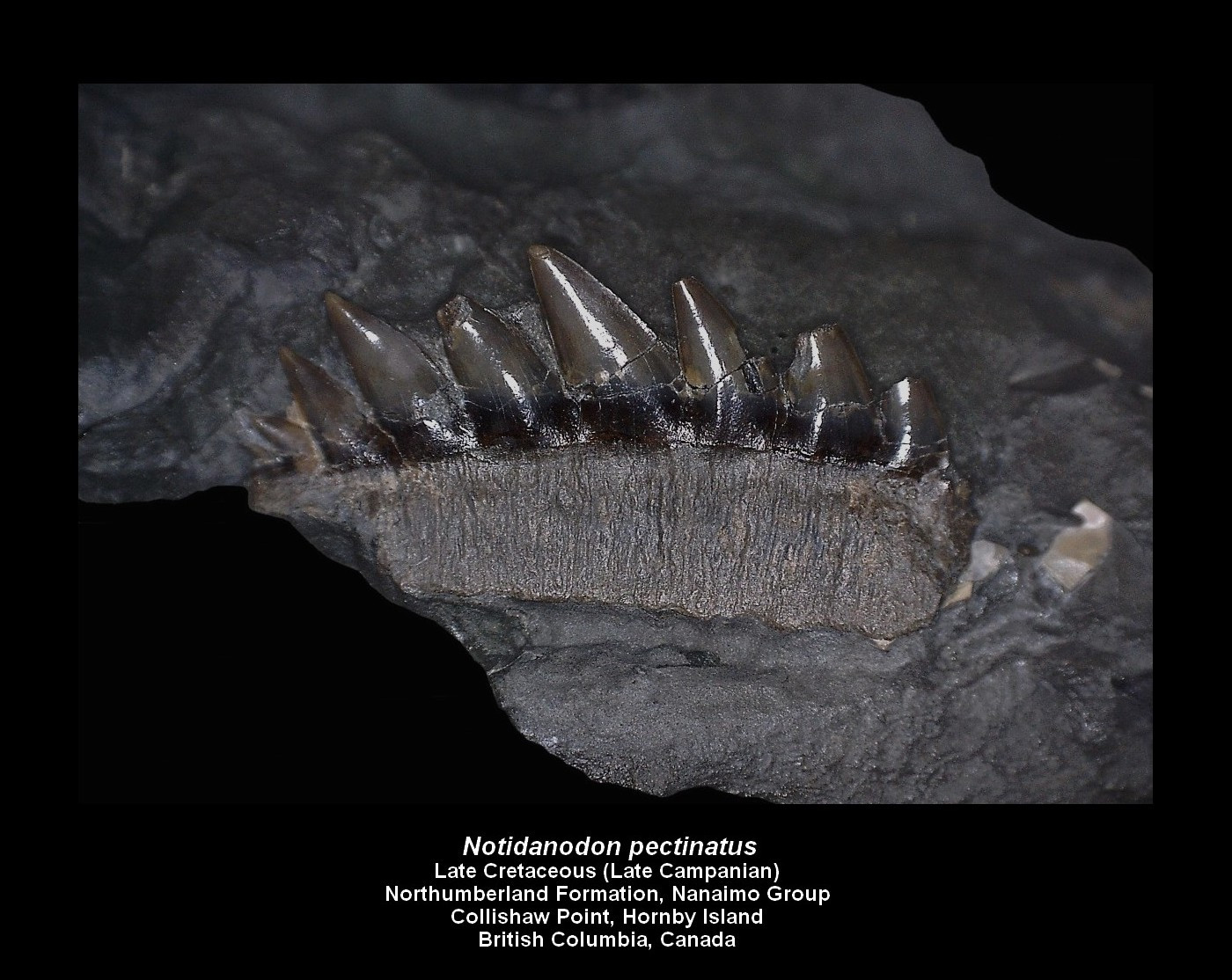Notidanodon pectinatus
(Agassiz, 1843)
Classification: Elasmobranchii Hexanchiformes Hexanchidae
Reference of the original description
Recherches sur les poissons fossiles, 15th and 16th livraisons (March 1843). Jent and Gassmann, Soleure (text) and H. Nicolet, Neuchâtel (planches). – vol. 3: [i]-[iv], 157-390, 382*-382**, 1–32, [33]-[34], pl. 1, 18, 22, 22a, 22b, 26a, 38, 40b, 40c, 40d, 45, 47
Recherches sur les poissons fossiles, 15th and 16th livraisons (March 1843). Jent and Gassmann, Soleure (text) and H. Nicolet, Neuchâtel (planches). – vol. 3: [i]-[iv], 157-390, 382*-382**, 1–32, [33]-[34], pl. 1, 18, 22, 22a, 22b, 26a, 38, 40b, 40c, 40d, 45, 47
Synonyms / new combinations and misspellings
Notidanus pectinatus, Notorhynchus pectinatus
Notidanus pectinatus, Notorhynchus pectinatus
Types
Notidanodon pectinatus
Notidanodon pectinatus
Description:
Citation: Notidanodon pectinatus (Agassiz, 1843): In: Database of fossil elasmobranch teeth www.shark-references.com, World Wide Web electronic publication, Version 12/2025
Please send your images of "Notidanodon pectinatus" to info@shark-references.com

Notidanoides pectinatus (Agassiz, 1843), Late Cretaceous, Late Campanian, Northumberland Formation, Nanalmo Group, Collishaw Point, Hornby Island, Canada, collection and © Adam Anderson

Notidanoides pectinatus (Agassiz, 1843), Late Cretaceous, Late Campanian, Northumberland Formation, Nanalmo Group, Collishaw Point, Hornby Island, Canada, collection and © Adam Anderson
Remarks
shark-references Species-ID=4131;
Links: Original description of Agassiz Recherches sur les Poissons Fossiles (1833-1843)
shark-references Species-ID=4131;
Links: Original description of Agassiz Recherches sur les Poissons Fossiles (1833-1843)
References

Global impact and selectivity of the Cretaceous-Paleogene mass extinction among sharks, skates, and rays. Science, 379, 802–806
DOI: 10.1126/science.abn2080

A shark fauna from the Campanian of Hornby Island, British Columbia, Canada: an insight into the diversity of Cretaceous deep-water assemblages. Historical Biology, 33(8), 1121–1182
DOI: 10.1080/08912963.2019.1681421
Discovery of the most ancient Notidanodon tooth (Neoselachii: Hexanchiformes) in the Late Jurassic of New Zealand. New considerations on the systematics and range of the genus. Palaeovertebrata, 42(1), Article e1
DOI: 10.18563/pv.42.1.e1

Crossing the boundary: an elasmobranch fauna from Stevns Klint, Denmark. Palaeontology, 57(3), 591–629
DOI: 10.1111/pala.12079

Palaeoenvironment and Shark Evolution across the K/T-boundary on Southern Zealand. Phd Thesis, Faculty of Science, University of Copenhagen

Summary of Mesozoic elasmobranch remains from Japan. In G. Arratia & G. Viohl (Eds.), Mesozoic Fishes 1 – Systematics and Paleoecology (pp. 73–82). Verlag Dr. Friedrich Pfeil

The extinct genus Notidanodon (Neoselachii, Hexanchiformes). In G. Arratia & G. Viohl (Eds.), Mesozoic Fishes 1 – Systematics and Paleoecology (pp. 63–72). Verlag Dr. Friedrich Pfeil

A record of Notidanodon pectinatus (Chondrichthyes, Hexanchiformes) in the Upper Cretaceous of the Antarctic Peninsula. Mesozoic Research, 1(2), 79–88
A confirmation of the validity of Notorhynchus pectinatus; the second record of this Upper Cretaceous Cowshark. Bulletin of the Southern California Academy of Sciences, 64(3), 122–126

A synopsis of the vertebrate fossils of the English Chalk. Proceedings of the Geologists' Association, 10(5/6), 273–338, 1 pl.
DOI: 10.1016/S0016-7878(88)80065-8
On the palaeontology of the selachian genus Notidanus CUVIER. Geological Magazine, decade 3, 3, 205–217, 253–259
Die Fische der Vorwelt, mit steter Berücksichtigung der lebenden Fische. Erster Band: Wirbelthiere. Dritte Abtheilung: Fische: i–xii, 1–467. Leipzig (Brockhaus).
A stratigraphical list of British fossils; arranged under the principal division of the British strata, with a few elementary remarks on their character and localities. London, Reeve Brothers, Strand, 132pp
Synoptical Table of British Fossil Fishes, Arranged in the Order of the Geological Formations. Report of the British Association for the Advancement of Science, 13th Meeting (1843), 194–207

Global impact and selectivity of the Cretaceous-Paleogene mass extinction among sharks, skates, and rays. Science, 379, 802–806
DOI: 10.1126/science.abn2080

A shark fauna from the Campanian of Hornby Island, British Columbia, Canada: an insight into the diversity of Cretaceous deep-water assemblages. Historical Biology, 33(8), 1121–1182
DOI: 10.1080/08912963.2019.1681421
Discovery of the most ancient Notidanodon tooth (Neoselachii: Hexanchiformes) in the Late Jurassic of New Zealand. New considerations on the systematics and range of the genus. Palaeovertebrata, 42(1), Article e1
DOI: 10.18563/pv.42.1.e1

Crossing the boundary: an elasmobranch fauna from Stevns Klint, Denmark. Palaeontology, 57(3), 591–629
DOI: 10.1111/pala.12079

Palaeoenvironment and Shark Evolution across the K/T-boundary on Southern Zealand. Phd Thesis, Faculty of Science, University of Copenhagen

Summary of Mesozoic elasmobranch remains from Japan. In G. Arratia & G. Viohl (Eds.), Mesozoic Fishes 1 – Systematics and Paleoecology (pp. 73–82). Verlag Dr. Friedrich Pfeil

The extinct genus Notidanodon (Neoselachii, Hexanchiformes). In G. Arratia & G. Viohl (Eds.), Mesozoic Fishes 1 – Systematics and Paleoecology (pp. 63–72). Verlag Dr. Friedrich Pfeil

A record of Notidanodon pectinatus (Chondrichthyes, Hexanchiformes) in the Upper Cretaceous of the Antarctic Peninsula. Mesozoic Research, 1(2), 79–88
A confirmation of the validity of Notorhynchus pectinatus; the second record of this Upper Cretaceous Cowshark. Bulletin of the Southern California Academy of Sciences, 64(3), 122–126

A synopsis of the vertebrate fossils of the English Chalk. Proceedings of the Geologists' Association, 10(5/6), 273–338, 1 pl.
DOI: 10.1016/S0016-7878(88)80065-8
On the palaeontology of the selachian genus Notidanus CUVIER. Geological Magazine, decade 3, 3, 205–217, 253–259
Die Fische der Vorwelt, mit steter Berücksichtigung der lebenden Fische. Erster Band: Wirbelthiere. Dritte Abtheilung: Fische: i–xii, 1–467. Leipzig (Brockhaus).
A stratigraphical list of British fossils; arranged under the principal division of the British strata, with a few elementary remarks on their character and localities. London, Reeve Brothers, Strand, 132pp
Synoptical Table of British Fossil Fishes, Arranged in the Order of the Geological Formations. Report of the British Association for the Advancement of Science, 13th Meeting (1843), 194–207

















